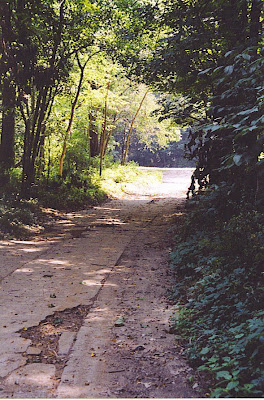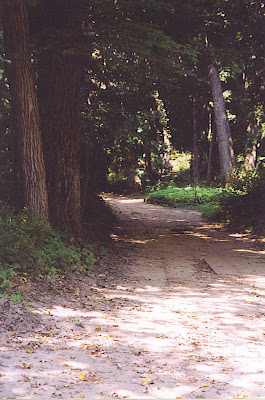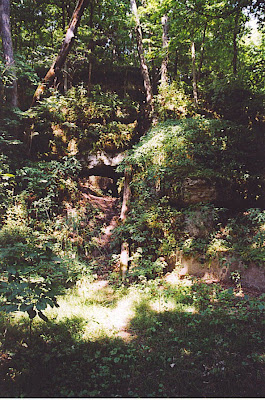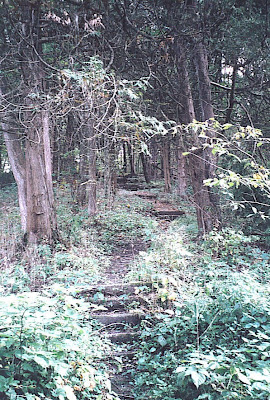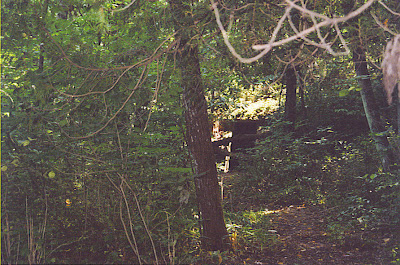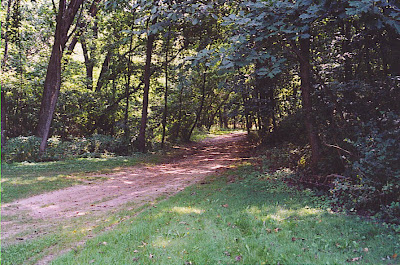 This card was mailed in 1908. It takes the visitor down The Promenade past the original Rustic Bandstand on the left. Coming up on the right is the triangle garden in front of The Pavilion. Keep walking and you would pass the The Refreshment Stand and The Bowling Alley. The Miner's Hut from the Nov. 21 post, Entrance to Union Park, is gone and replaced by a Pavilion. Since there are no people in the image, I am guessing that it was taken in the early morning before the park opened. Notice that as in the previous post, there are no benches in The Waiting Area.
This card was mailed in 1908. It takes the visitor down The Promenade past the original Rustic Bandstand on the left. Coming up on the right is the triangle garden in front of The Pavilion. Keep walking and you would pass the The Refreshment Stand and The Bowling Alley. The Miner's Hut from the Nov. 21 post, Entrance to Union Park, is gone and replaced by a Pavilion. Since there are no people in the image, I am guessing that it was taken in the early morning before the park opened. Notice that as in the previous post, there are no benches in The Waiting Area.
Take a virtual stroll through Union Park in Dubuque, Iowa with images from its heyday & photos from the present.
Monday, December 21, 2009
The Promenade, Union Park, postcard 5
 This card was mailed in 1908. It takes the visitor down The Promenade past the original Rustic Bandstand on the left. Coming up on the right is the triangle garden in front of The Pavilion. Keep walking and you would pass the The Refreshment Stand and The Bowling Alley. The Miner's Hut from the Nov. 21 post, Entrance to Union Park, is gone and replaced by a Pavilion. Since there are no people in the image, I am guessing that it was taken in the early morning before the park opened. Notice that as in the previous post, there are no benches in The Waiting Area.
This card was mailed in 1908. It takes the visitor down The Promenade past the original Rustic Bandstand on the left. Coming up on the right is the triangle garden in front of The Pavilion. Keep walking and you would pass the The Refreshment Stand and The Bowling Alley. The Miner's Hut from the Nov. 21 post, Entrance to Union Park, is gone and replaced by a Pavilion. Since there are no people in the image, I am guessing that it was taken in the early morning before the park opened. Notice that as in the previous post, there are no benches in The Waiting Area.
Sunday, December 13, 2009
The Promenade, Union Park, postcard 4
 This image was taken from The Waiting Area. On the right from the nearest building to the farthest you can see The Refreshment Stand, The Bowling Alley, and another pavilion area (probably used for picnics). On the left you can see the stairs to the original Rustic Bandstand. Beyond that you can see a crowd of people in the plaza area around the second bandstand.
This image was taken from The Waiting Area. On the right from the nearest building to the farthest you can see The Refreshment Stand, The Bowling Alley, and another pavilion area (probably used for picnics). On the left you can see the stairs to the original Rustic Bandstand. Beyond that you can see a crowd of people in the plaza area around the second bandstand. An interesting feature of this postcard is the lack of park benches in The Waiting Area. Where have they gone? I would guess this image was taken between 1909-1910 because of the clothing style and also the cement work looks rather new. The planters also seem to be a new feature in this image.
Visitors would continue down The Promenade to get to other areas of the park including the children's playground and in later years the Mammoth Theater. This postcard was mailed in 1912.
Saturday, December 12, 2009
Union Park Now: The Bowling Alley
Monday, December 7, 2009
The Promenade, Union Park, postcard 3
 The image "Center View of Union Park, Dubuque" was taken across from the Pavilion overlooking the Promenade and Waiting Area. The Rustic Bandstand is just out of sight, but music would have flooded the area on a day like the one depicted here. The buildings from the left are another pavilion, the Bowling Alley, and the refreshment (or ice cream) stand. The little building in the upper left-hand corner of the postcard is described as toadstool shaped pagoda in Michael A. Boge's book "Union Park: A Place of Memories. The park had many more so-called pagodas (which were originally miner's huts) when it was known as Stewart Park.
The image "Center View of Union Park, Dubuque" was taken across from the Pavilion overlooking the Promenade and Waiting Area. The Rustic Bandstand is just out of sight, but music would have flooded the area on a day like the one depicted here. The buildings from the left are another pavilion, the Bowling Alley, and the refreshment (or ice cream) stand. The little building in the upper left-hand corner of the postcard is described as toadstool shaped pagoda in Michael A. Boge's book "Union Park: A Place of Memories. The park had many more so-called pagodas (which were originally miner's huts) when it was known as Stewart Park.Take note of the fountain in front of the tree with 3 trunks that still grows today. Also, there were many planters on the grounds. The park was well-known for its beautiful flowers. The postcard in my collection was used in 1922; however, the straw hats worn by the men were typical of the 1910s.
Sunday, December 6, 2009
Saturday, December 5, 2009
Union Park Now: Looking Back at the Entrance 1
Sunday, November 29, 2009
Entrance to Union Park, postcard 2
 This image was taken directly in front of the pavilion, looking back towards the Entrance and the Loop. A trolley with people onboard is visible. The Lodge can be seen through the trees in the background. There is a bridge off the left hand side of the sidewalk (to the restrooms). Note that the electrical pole is no longer made of wood. The man is seated on one of the benches in front of the Pavilion (which is not visible in this scene); he looks very similar to the gentleman from the October 26 post, The Pavilion, Union Park. Could it be the same man?
This image was taken directly in front of the pavilion, looking back towards the Entrance and the Loop. A trolley with people onboard is visible. The Lodge can be seen through the trees in the background. There is a bridge off the left hand side of the sidewalk (to the restrooms). Note that the electrical pole is no longer made of wood. The man is seated on one of the benches in front of the Pavilion (which is not visible in this scene); he looks very similar to the gentleman from the October 26 post, The Pavilion, Union Park. Could it be the same man?
Saturday, November 28, 2009
Sunday, November 22, 2009
Union Park Now: The Entrance 1
 This is almost the same view as in the previous post. Picture yourself walking down the Promenade have just disembarked from the trolley. Up ahead on the right is the Triangle Garden, which indicates where the Pavilion once stood. Continue walking and you would have been passing the ice cream stand and the bowling alley. To the left would have been the Waiting Area, which is now overgrown with weeds and trees, and the Bandstand.
This is almost the same view as in the previous post. Picture yourself walking down the Promenade have just disembarked from the trolley. Up ahead on the right is the Triangle Garden, which indicates where the Pavilion once stood. Continue walking and you would have been passing the ice cream stand and the bowling alley. To the left would have been the Waiting Area, which is now overgrown with weeds and trees, and the Bandstand.Saturday, November 21, 2009
Entrance to Union Park
 Entitled "Entrance Union Park, Dubuque, Iowa," this image depicts The Promenade in its early years. Although this postcard was used in 1907, it depicts a scene prior to 1904 as there is a Miner's Hut left over from Stewart Park days. The electrical poles are crude. While there is no picnic pavilion to the right yet, the cement does look new. The Bandstand to the left is the original and looks newly built as well. As the Promenade curves to the left, there is a railing indicated that the path goes over the creek. Further back there is a little bridge where the path branches off.
Entitled "Entrance Union Park, Dubuque, Iowa," this image depicts The Promenade in its early years. Although this postcard was used in 1907, it depicts a scene prior to 1904 as there is a Miner's Hut left over from Stewart Park days. The electrical poles are crude. While there is no picnic pavilion to the right yet, the cement does look new. The Bandstand to the left is the original and looks newly built as well. As the Promenade curves to the left, there is a railing indicated that the path goes over the creek. Further back there is a little bridge where the path branches off.
Sunday, November 15, 2009
Union Park Now: The Waiting Area
Saturday, November 14, 2009
The View from the Pavilion, Union Park
 This is one of my favorite postcards; I ended up with 2 of them both postmarked 1909. The photographer would have had to have been standing at the entrance (perhaps on the stairs) of The Pavilion and facing The Promenade & Waiting Area. By this time the ugly wooden electric poles had been replaced with elegant light posts and light fixtures.
This is one of my favorite postcards; I ended up with 2 of them both postmarked 1909. The photographer would have had to have been standing at the entrance (perhaps on the stairs) of The Pavilion and facing The Promenade & Waiting Area. By this time the ugly wooden electric poles had been replaced with elegant light posts and light fixtures. People gathered on the benches to wait for their friends and family to arrive. The young girl on the right is eating an ice cream cone. Note the straw hats for men and decorated, large hats for women that were all the rage in the early 1900s. Everyone looks so happy. Perhaps they were waiting for a dance to start.
Sunday, November 8, 2009
Union Park Now: The Pavilion 2
Saturday, November 7, 2009
Union Park Now: The Pavilion 1
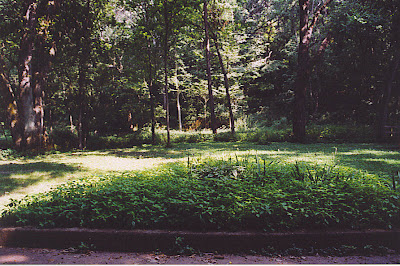 This photo from 2003 was taken standing on the Promenade directly in front of where the Pavilion once stood. The tree with 3 trunks is in the background to the far left. The triangle garden is directly front and center. If you get permission to visit in May you will see that purple irises still bloom in the garden. Later in the summer the garden gets overgrown with weeds. Restoring this garden would be a great project for a gardening or a scouting group.
This photo from 2003 was taken standing on the Promenade directly in front of where the Pavilion once stood. The tree with 3 trunks is in the background to the far left. The triangle garden is directly front and center. If you get permission to visit in May you will see that purple irises still bloom in the garden. Later in the summer the garden gets overgrown with weeds. Restoring this garden would be a great project for a gardening or a scouting group.Sunday, November 1, 2009
Union Park Now: The Tree with 3 Trunks
 This tree can be seen in several postcards of The Pavilion. It stood to the left of the building. Even today it's a very distinctive structure. This photo was taken in September, 2008. In previous photos the tree was marred with different colored paint. Local kids like to use Union Park for paintball practice and this tree seems to be a favorite target. What a shame.
This tree can be seen in several postcards of The Pavilion. It stood to the left of the building. Even today it's a very distinctive structure. This photo was taken in September, 2008. In previous photos the tree was marred with different colored paint. Local kids like to use Union Park for paintball practice and this tree seems to be a favorite target. What a shame.
Monday, October 26, 2009
The Pavilion, Union Park
 This is "The Pavilion" or the dance hall. It was the first building to the right as visitors walked into the park and down The Promenade. The creek actually ran under the corner of the dance hall. This is a charming postcard; I have seen it tinted with a green roof in other collections. Note the 2 girls on the veranda and the man seated on the bench. You will see him again in an upcoming post.
This is "The Pavilion" or the dance hall. It was the first building to the right as visitors walked into the park and down The Promenade. The creek actually ran under the corner of the dance hall. This is a charming postcard; I have seen it tinted with a green roof in other collections. Note the 2 girls on the veranda and the man seated on the bench. You will see him again in an upcoming post.Under magnification, you can see electric lines and hanging lights. Also, there is faint writing in pencil visible on the roof. It is difficult to decipher and I can not make out the second word. It says, " Dance _______ hall floor"
All that remains of the site today is the tree with 3 trunks on the left and the triangle garden in the center of the sidewalk. To this day purple Irises and Bleeding Hearts still bloom in the garden even though it is overgrown with weeds. It would be a great restoration project for someone interested in historical gardening. Also, the portion of sidewalk in the bottom center of the image leads to the Waiting Area.
When the park was dismantled, the fountain on the left ended up at the Ryan House in Dubuque where customers could see it first hand. However, now it may be residing at the Dubuque Arboretum. According to Encyclopedia Dubuque, the other fountain, went to the former home of Joseph A. Rhomberg.
Sunday, October 18, 2009
The Recreation Grounds
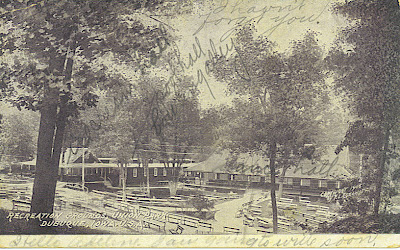 This is an early shot of The Recreation Grounds of Union Park. This main sidewalk in this area was later renamed The Promenade. The vast number of benches reflects the popularity of the park. Also, it illustrates the function of this area later nicknamed The Waiting Area.
This is an early shot of The Recreation Grounds of Union Park. This main sidewalk in this area was later renamed The Promenade. The vast number of benches reflects the popularity of the park. Also, it illustrates the function of this area later nicknamed The Waiting Area. There are 2 distinct styles of handwriting on this postcard. The first hand is written by the sender. The second hand is responsible for the notes on the postcard image directly. Written in pencil, the writer noted the function of the buildings. The Pavilion is labeled "dance hall". There are also notations for "ice cream hall," "pool hall," and "bowling alleys."
This image has a notation: Copyright 1906 by F.L. EGELHOF. He is the same photographer who took the black and white image of 4 trolleys posted earlier. The two images could have been taken on the same day.
It is interesting to note that there are no fountains in front of Pavilion. Also, you can still see the old style wooden electric poles; therefore, photo was probably taken between 1901 and 1904. This card was postally used in 1907.
Friday, October 16, 2009
The Promenade, Union Park, postcard 2
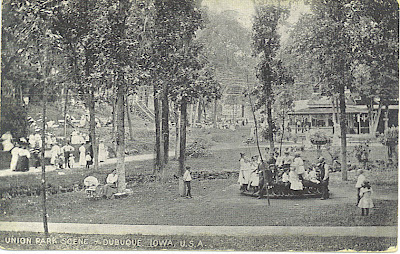 This postcard is entitled "Union Park Scene, Dubuque, Iowa, U.S.A." It was produced by the Acme Art Store. The viewpoint for this black and white postcard was taken from the right of the Waiting Station and looks towards the front lawn of The Pavilion and an area know as The Waiting Area on the left in the background. You can see benches in this area for people to wait and meet their family and friends. You can just make out the stairs to the original Rustic Bandstand.
This postcard is entitled "Union Park Scene, Dubuque, Iowa, U.S.A." It was produced by the Acme Art Store. The viewpoint for this black and white postcard was taken from the right of the Waiting Station and looks towards the front lawn of The Pavilion and an area know as The Waiting Area on the left in the background. You can see benches in this area for people to wait and meet their family and friends. You can just make out the stairs to the original Rustic Bandstand.The sidewalk in front leads to the restrooms. At the time of this photo, there was a merry-go-round for children to play on. It was located on the lawn of the Pavilion along with large planters. You can also see the creek cutting through the lawn. The sidewalk off to the left was known as The Promenade; you can see people strolling down it. The building on the right is the Ice Cream Stand. In the background center there is a large sign advertising "Chatauqua Opens Today".
The card in my collection was not postally used. However, based on the clothing in the image I'm going to estimate that it was taken around 1910.
Wednesday, October 14, 2009
Union Park Now: The Promenade
Monday, October 12, 2009
The Promenade, Union Park, postcard 1
 This postcard, entitled "Scene in Union Park, Dubuque, Iowa" shows the entrance to the promenade as it appeared almost 90 years ago. Imagine stepping off the trolley and leaving the waiting station. Immediately to the right are a drinking fountain and a bridge/sidewalk leading to the restrooms. The first building on the right was known as "The Pavilion"; it served as a dance hall. One of the fountains and several planters are visible through the trees. Behind the greeters, you can see the bowling alley and refreshment/ice cream stand. The picnic pavilion curves off to the left. The crude light poles have been replaced by fancy iron work.
This postcard, entitled "Scene in Union Park, Dubuque, Iowa" shows the entrance to the promenade as it appeared almost 90 years ago. Imagine stepping off the trolley and leaving the waiting station. Immediately to the right are a drinking fountain and a bridge/sidewalk leading to the restrooms. The first building on the right was known as "The Pavilion"; it served as a dance hall. One of the fountains and several planters are visible through the trees. Behind the greeters, you can see the bowling alley and refreshment/ice cream stand. The picnic pavilion curves off to the left. The crude light poles have been replaced by fancy iron work.The cement work in this postcard looks new. I would guess this image was taken around 1910. Most of the sidewalks are still there today in fairly good condition.
Saturday, October 3, 2009
Union Park Now: The Roller Coaster area
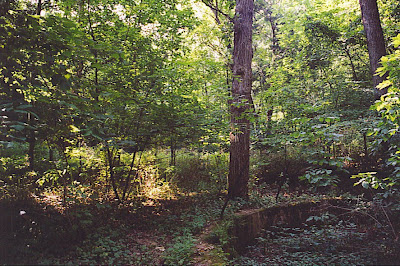
 Union Park was once home to a roller coaster. It was torn down a long time ago, when the park was closed. According to The Roller Coaster Database, the Union Park ride operated from 1908 - 1934. It was constructed by C. O. Breinig. It was a wooden, sit-down type of coaster in the classic figure eight pattern; it used side friction. My research is ongoing; however, the park's roller coaster may have been Iowa's first. Wood from the ride was later used to build a barn in Asbury, IA.
Union Park was once home to a roller coaster. It was torn down a long time ago, when the park was closed. According to The Roller Coaster Database, the Union Park ride operated from 1908 - 1934. It was constructed by C. O. Breinig. It was a wooden, sit-down type of coaster in the classic figure eight pattern; it used side friction. My research is ongoing; however, the park's roller coaster may have been Iowa's first. Wood from the ride was later used to build a barn in Asbury, IA. The top photo above shows the valley where the coaster once resided. It rested south of the fishpond. In fact, you can see the fishpond in the lower right-hand corner of the photo. The second photo shows the creek that runs through that same valley. It's difficult to imagine a roller coaster in this area, but it is possible if you simply picture it without all the trees and forest undergrowth. One of these days, I'll have to go searching for the cement post holes that are supposedly still there marking the site of the Dubuque's only roller coaster.
Sunday, September 27, 2009
Union Park Now: The Fishpond 2
Union Park Now: The Fishpond 1
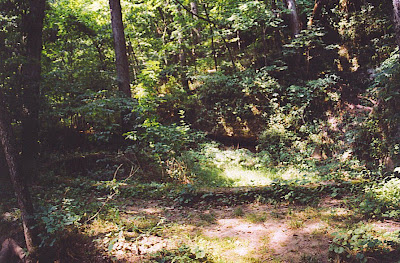
 I have not been able to find any postcards of either the roller coaster or the fishpond back when Union Park was the place to be. The top photo shows the circular outline of the pond. The second photo gives you a better idea as to the curvature and depth of the pond. Keep in mind that the pond would have been deeper in years gone by. Soil and plant life have accumulated over the years. When I stood in the pond area, it was about 18" deep. It reminds me of the pond at Eagle Point Park in Dubuque.
I have not been able to find any postcards of either the roller coaster or the fishpond back when Union Park was the place to be. The top photo shows the circular outline of the pond. The second photo gives you a better idea as to the curvature and depth of the pond. Keep in mind that the pond would have been deeper in years gone by. Soil and plant life have accumulated over the years. When I stood in the pond area, it was about 18" deep. It reminds me of the pond at Eagle Point Park in Dubuque.Sunday, September 20, 2009
Union Park Now: The Stairs to Wonder Cave
Saturday, September 19, 2009
Wonder Cave, Union Park postcard 1
 This image shows the interior of Wonder Cave after renovations were complete in 1908. If you look closely, there appears to be water in the lower right-hand corner of the image. In fact, prior to the renovations, trips through the pitch black cave were slippery and treacherous. The renovations included the addition of a compressed walkway, stairs, bridges, and an exit. The entrance of the cave enticed visitors through its archway with blinking lights. The cave was a popular attraction especially because it was so cool in the Summer.
This image shows the interior of Wonder Cave after renovations were complete in 1908. If you look closely, there appears to be water in the lower right-hand corner of the image. In fact, prior to the renovations, trips through the pitch black cave were slippery and treacherous. The renovations included the addition of a compressed walkway, stairs, bridges, and an exit. The entrance of the cave enticed visitors through its archway with blinking lights. The cave was a popular attraction especially because it was so cool in the Summer. This postcard was used in 1909. According to Iowa Underground (2004) by Greg A. Brick, this cave was originally known as Timmen's Cave. The former lead mine was rediscovered by Greek rail layers as they put in the trolley tracks in 1900 or 1901. The cave is located on the hill south of the Loop. The entrance was bombed shut after the park closed in 1934. At the present time the cave is unstable and off-limits to visitors.
Sunday, September 13, 2009
Union Park Now: The Spring House
Tuesday, September 8, 2009
Union Park Now: The Lodge
 This is the same sidewalk going up to Wonder Cave as pictured in the postcard of the Lodge. As you can see, the tiny pine tree has grown into a giant. As you begin the ascent to the cave, if you look to the left you can see the crumbling foundations of the greenhouses. Beyond the greenhouses, the spring house is visible through the trees from the sidewalk as well (see upcoming posts).
This is the same sidewalk going up to Wonder Cave as pictured in the postcard of the Lodge. As you can see, the tiny pine tree has grown into a giant. As you begin the ascent to the cave, if you look to the left you can see the crumbling foundations of the greenhouses. Beyond the greenhouses, the spring house is visible through the trees from the sidewalk as well (see upcoming posts).
Sunday, September 6, 2009
The Lodge, Union Park
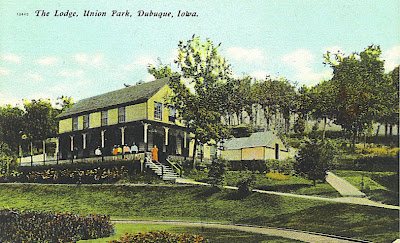 The Lodge was located on the South end of the Loop. The caretaker, Mr. Bonz, and his family lived in the Lodge; perhaps they are the people pictured on the porch in this postcard. Behind the Lodge, one can see the greenhouses, the small buildings in the background. Mr. Bonz used to store the bulbs and plants in the greenhouses during the Winter and replant them in the Spring. Not visible in this postcard are the well and the spring house.
The Lodge was located on the South end of the Loop. The caretaker, Mr. Bonz, and his family lived in the Lodge; perhaps they are the people pictured on the porch in this postcard. Behind the Lodge, one can see the greenhouses, the small buildings in the background. Mr. Bonz used to store the bulbs and plants in the greenhouses during the Winter and replant them in the Spring. Not visible in this postcard are the well and the spring house.Take a close look at the sidewalk leading up the hill and the little pine tree in this image. Both the sidewalk and tree still exist as you will see in the next post. The tree has grown into a giant specimen. The sidewalk is still passable and once lead park visitors up to Wonder Cave.
Sunday, August 30, 2009
Saturday, August 29, 2009
Union Park Now: The Waiting Station Platform 2
 This photo illustrates the silt buildup on the Waiting Station platform. This image was taken in 2003 from the center of the platform looking South. From time to time the platform is cleared of silt. You can see that plants have started to grow on top of the soil that was deposited there. If left alone, this area will be reclaimed by nature someday.
This photo illustrates the silt buildup on the Waiting Station platform. This image was taken in 2003 from the center of the platform looking South. From time to time the platform is cleared of silt. You can see that plants have started to grow on top of the soil that was deposited there. If left alone, this area will be reclaimed by nature someday.
Sunday, August 23, 2009
Union Park Now: The Waiting Station Platform 1
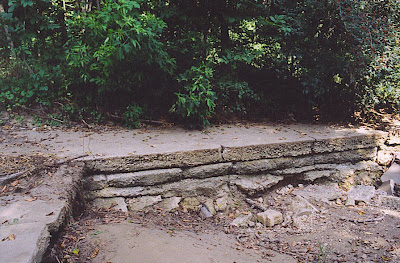 This is an image of the right hand side of the Waiting Station platform. It appears that the platform was built up over the years as there are layer upon layer of cement. This would be due to the silt that builds up every Spring. The creek runs under the platform and continues down the trolley path. Over the years big chunks of the cement platform have crumbled into the creek bed and have been carried downstream. Notice the bushes and trees that are crowding in on the platform area.
This is an image of the right hand side of the Waiting Station platform. It appears that the platform was built up over the years as there are layer upon layer of cement. This would be due to the silt that builds up every Spring. The creek runs under the platform and continues down the trolley path. Over the years big chunks of the cement platform have crumbled into the creek bed and have been carried downstream. Notice the bushes and trees that are crowding in on the platform area.
Saturday, August 22, 2009
Union Park Now: Dry Creek Bed alongside the Trolley Path
 The creek ran alongside the trolley tracks. As you can see in this photo, it is usually dry. One can walk in the dry creek bed and find interesting artifacts both on the bottom and sides of the creek. Up farther in the park itself, there are areas where stone work is visible in an effort to control the meandering water.
The creek ran alongside the trolley tracks. As you can see in this photo, it is usually dry. One can walk in the dry creek bed and find interesting artifacts both on the bottom and sides of the creek. Up farther in the park itself, there are areas where stone work is visible in an effort to control the meandering water.
Sunday, August 16, 2009
Union Park Now: The Loop
 This is a photo of The Loop & Waiting Station area as it appears today. The dark area in the center is the entrance. If you stand in the middle of the loop area, you can see that it still bears a resemblance to the postcards in the previous posts, The Loop postcards 1 & 3. The Loop still retains its circular shape as it did over 100 years ago. The cement platform and sidewalks are still in existence.
This is a photo of The Loop & Waiting Station area as it appears today. The dark area in the center is the entrance. If you stand in the middle of the loop area, you can see that it still bears a resemblance to the postcards in the previous posts, The Loop postcards 1 & 3. The Loop still retains its circular shape as it did over 100 years ago. The cement platform and sidewalks are still in existence. In the following posts you will see photos of the platform up close. Over the years I have seen it begin to crumble and erode. Every Spring the silt that builds up from melting snow and run off is removed. If it weren't removed, all evidence of the sidewalks and platform would be hidden.
Saturday, August 15, 2009
Union Park Now: Entering the Loop
 This image was taken from the same vantage point as the previous post; however, I was facing West towards the Loop instead of East. You can just see the Loop come into view. Imagine the Waiting Station directly ahead with flower gardens in the center. The Lodge would be to your left on the hillside.
This image was taken from the same vantage point as the previous post; however, I was facing West towards the Loop instead of East. You can just see the Loop come into view. Imagine the Waiting Station directly ahead with flower gardens in the center. The Lodge would be to your left on the hillside.
Sunday, August 9, 2009
Union Park Now: The Trolley Path
Saturday, August 8, 2009
The Waiting Station, Union Park
 The Depot at Union Park was also commonly known as The Waiting Station. This is one of my favorite images featuring the park in its heyday. The signs on trolley #71 advertise "Baseball Today" and "Union Park Shows - Twice Daily - Big - Free". It's a very crowded image which hints at the popularity of the park. The clothing is typical of the 1910s. Back in the early 1900s, a trip to Union Park was a special occasion; visitor dressed up in their Sunday best for a day at the park. Note that in the background to the left-hand side of The Waiting Station, The Pavilion is just visible.
The Depot at Union Park was also commonly known as The Waiting Station. This is one of my favorite images featuring the park in its heyday. The signs on trolley #71 advertise "Baseball Today" and "Union Park Shows - Twice Daily - Big - Free". It's a very crowded image which hints at the popularity of the park. The clothing is typical of the 1910s. Back in the early 1900s, a trip to Union Park was a special occasion; visitor dressed up in their Sunday best for a day at the park. Note that in the background to the left-hand side of The Waiting Station, The Pavilion is just visible.
Sunday, August 2, 2009
The Depot, Union Park, postcard 3

This image features The Depot (a.k.a. The Waiting Station) tinted in a brick red color instead of the green we've seen previously. The plants featured in The Loop area have a different configuration. It appears that cannas were planted in the center garden that summer. Union Park was well-known for its collection of flowering plants. The groundskeeper, Mr. Bonz, kept the bulbs in the greenhouses during the Winter and replanted them in the Spring.
Saturday, August 1, 2009
The Depot, Union Park, postcard 2

The Waiting Station was created to shelter patrons from inclement weather. It also created a grand entrance area to the park. This image features a summer open-air trolley, number 95. Notice the man standing by the flowerbed in the center; possibly he is the groundkeeper Mr. Bonz or perhaps Park Manager L.D. Mathes. Who knows? Under magnification it is possible to see little bridges that divert visitors to the left and right after arriving at the park. Also, you can see a building off to the right of the Waiting Station situated on the hill. Possibly these are the restrooms. This item was postally used in 1910.
Sunday, July 26, 2009
The Depot, Union Park, postcard 1
 An early shot of the new depot, A.K.A. The Waiting Station, in a postcard entitled "The Loop and Station in Union Park, Dubuque, IA." It has a 1909 postmark, and the image was obviously taken after 1904. Notice that the configuration of the flowers in the center of the loop has changed. Also, there are flower beds along the tracks as the trolley enters and leaves the Loop.
An early shot of the new depot, A.K.A. The Waiting Station, in a postcard entitled "The Loop and Station in Union Park, Dubuque, IA." It has a 1909 postmark, and the image was obviously taken after 1904. Notice that the configuration of the flowers in the center of the loop has changed. Also, there are flower beds along the tracks as the trolley enters and leaves the Loop. By this time the ugly electric poles have disappeared and we start to see hanging light fixtures (like the one in the center of the upper third of this postcard). From the center of the Waiting Station and veering off to the left, the sidewalk to the Fish Pond is visible. Also, the Bowling Alley and The Pavilion are visible through the Waiting Station and the trees.
Saturday, July 25, 2009
Union Park Random Facts
From time to time I will post trivia related to Union Park as part of a series of random facts. Try these out for starters:
- The area that Union Park was located in is now known as Union Park Hollow.
- It is geographically classified as a valley*.
- The valley has an elevation of 633 feet* (or 193 meters).
- The time zone for that part of the world is Central Time (CT) which is UTC-6 during Standard Time and UTC-5 during Daylight Saving Time.
- The Latitude* is 42-32'26" N and the Longitude* is 090-41'38" W
More trivia will be posted in the future, so visit often!
Note: The asterisk (*) indicates information available at Lat-Long.com Also, for more information on time zones, click here.
The Loop, Union Park, postcard 4
 Very similar to upcoming post, The Depot, Union Park, Postcard 2, this card is postmarked 1908. The image was most likely taken from the porch of The Lodge. The electric poles and wires from the earlier images are no longer there. The rustic railing from the loading dock has been removed. New cement work is visible in the sidewalks and stairs.
Very similar to upcoming post, The Depot, Union Park, Postcard 2, this card is postmarked 1908. The image was most likely taken from the porch of The Lodge. The electric poles and wires from the earlier images are no longer there. The rustic railing from the loading dock has been removed. New cement work is visible in the sidewalks and stairs.
Monday, July 20, 2009
The Loop, Union Park, postcard 3

This is a color postcard from an era similar to the previous post. This postcard was postally used in 1907, but again the image was most likely taken between 1900 - 1904 due to the style of the loading docks and railings. The Bowling Alley is visible in the background behind the trolley. Picnic tables are visible on the hillside to the right. Also, note the crude electric poles which will change over time. The flower beds again feature cannas. The garden in the center has changed configuration.
Sunday, July 12, 2009
The Loop, Union Park, postcard 2
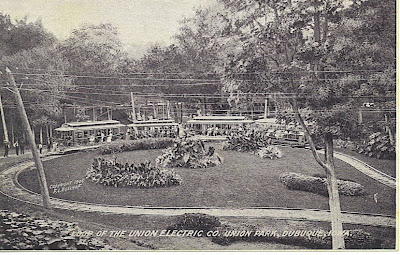 This postcard is entitled Loop of the Union Electric Co. Union Park, Dubuque, Iowa. This image appears to have been taken from the Lodge. It has a copyright date of 1906 by F. L. EGELHOF. However, with no Waiting Station present, I would guess that the image was taken prior to 1904.
This postcard is entitled Loop of the Union Electric Co. Union Park, Dubuque, Iowa. This image appears to have been taken from the Lodge. It has a copyright date of 1906 by F. L. EGELHOF. However, with no Waiting Station present, I would guess that the image was taken prior to 1904. Once again the Loop is featured as it appeared in the early days. Notice the 4 trolleys lined up with people boarding. The building behind the 2nd trolley appears to be the Bowling Alley. The Pavilion is just visible behind the 3rd and 4th trolley cars. Flowering cannas are often featured in the gardens. The flowers and plants pictured in the center of the loop have a very similar configuration to the next post.
Saturday, July 11, 2009
The Loop, Union Park, postcard 1
 In the early days of Union Park, the Loop was simply that, a loop of tracks with a dock-like platform for letting passengers on and off. If you look closely, you can just make out the railing on the platform (to the right). If you look closely, the Bowling Alley is just barely visible to the right of the railing. Since there is no Waiting Station in this image, I'm going to estimate that this was one of the earlier images of Union Park probably taken between 1900 - 1904.
In the early days of Union Park, the Loop was simply that, a loop of tracks with a dock-like platform for letting passengers on and off. If you look closely, you can just make out the railing on the platform (to the right). If you look closely, the Bowling Alley is just barely visible to the right of the railing. Since there is no Waiting Station in this image, I'm going to estimate that this was one of the earlier images of Union Park probably taken between 1900 - 1904.Over the following series of postcards, pay attention to the flower beds inside the Loop. Notice how the beds change from year to year with the flowers and bulbs being reused in different patterns.
Friday, July 10, 2009
The Trolleys to Union Park
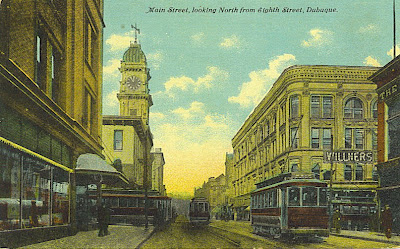 During the 1900s & 1910s, the only mode of transportation in and out of Union Park was the trolleys. Above is an image of the trolleys in downtown Dubuque circa 1909. The trolleys in this postcard are enclosed. Usually the trolleys to Union Park were summer open-air trolleys as you will see over the next few posts. None of the trolley numbers are visible. Before cars became commonplace, trolleys served as an alternate form of transportation to the horse and buggy.
During the 1900s & 1910s, the only mode of transportation in and out of Union Park was the trolleys. Above is an image of the trolleys in downtown Dubuque circa 1909. The trolleys in this postcard are enclosed. Usually the trolleys to Union Park were summer open-air trolleys as you will see over the next few posts. None of the trolley numbers are visible. Before cars became commonplace, trolleys served as an alternate form of transportation to the horse and buggy. According to Michael M. Boge's book, Union Park: A Place of Memories, the trolley line to Union Park began at 6th and Iowa streets. The line continued out Couler on what is now Central or Highway 52 and curved into the valley to the entrance of Union Park. The trip cost 15 cents each way. I have not been able to obtain an image of the trolleys in that location. The postcard above is the closest I could find to illustrate what Dubuque looked like in that era. I'm hoping to visit Dubuque this fall for the University of Dubuque Homecoming celebration. Then I will take photos of this same image as well as the location at 6th & Iowa. The department store on the right is Willners. The sign in the top floor windows say J.W.? Law Offices. I will try to do more research to discover who the attorney was. I am also in search of newspaper articles and maps to illustrate the trolley routes. Also, the time on the clock is 11:55 (we'll assume a.m.)
Below is an approximation of the trolley line to Union Park. It is by no means accurate, but it is a start. The map is interactive and you can drag the image around to follow the blue line to Union Park.
CommunityWalk Map - Trolley to Union Park, Dubuque, IA

Thursday, July 9, 2009
Share Your Photos
Do you have more information or insights about Union Park? Do you possess historical family photos taken in Union Park? Would you would like to share your information and images with the world? Consider sharing them here at Union Park: Then & Now. Full credit will be given to your contribution.
I'm particularly interested in photos of the roller coaster or the fish pond as well as the interior of the Mammoth Theatre. Family photos of the dance hall or the wading pool would be a great addition as well. If you are interested in sharing, please email me.
I'm particularly interested in photos of the roller coaster or the fish pond as well as the interior of the Mammoth Theatre. Family photos of the dance hall or the wading pool would be a great addition as well. If you are interested in sharing, please email me.
Stewart Park
In the early days of the electric business, it was difficult to convince people to patronize the electric trolley system. Thus the Dubuque Electric Railway, Light & Power Company sought a way to showcase the service and purchased approximately 40 acres of land from the Stewart Property to create a park. The trolley line, operated by the Allen & Swiney Motor Line, was extended out to the proposed park, which was to be called Stewart Park. The only way to gain entrance to the new park was by trolley, thereby increasing patronage.
The park was named for William Graham (W.G.) Stewart, a prosperous Dubuqueland resident. W.G. Stewart settled in Dubuque in 1834 where he pursued mining, smelting, and farming. He also had many other interest that served Dubuque County well. For example, he was elected the county's first sheriff and served on the Board of Supervisors. Additionally, he was a state senator and the county treasurer. Over the years he accumulated 900 acres of land. In 1890 at the age of 77, he "donated" some of his farmland, then known as Stewart's Grove, for the proposed park. Stewart park operated from 1890 to 1900. It was known as Union Park from 1901 until it closed in 1934.
The park was named for William Graham (W.G.) Stewart, a prosperous Dubuqueland resident. W.G. Stewart settled in Dubuque in 1834 where he pursued mining, smelting, and farming. He also had many other interest that served Dubuque County well. For example, he was elected the county's first sheriff and served on the Board of Supervisors. Additionally, he was a state senator and the county treasurer. Over the years he accumulated 900 acres of land. In 1890 at the age of 77, he "donated" some of his farmland, then known as Stewart's Grove, for the proposed park. Stewart park operated from 1890 to 1900. It was known as Union Park from 1901 until it closed in 1934.
Book Review: Union Park: a place of memories
I first heard of Union Park when I was a freshman at Wahlert High School, Dubuque. The topic was part of a unit on Dubuque History in Mr. Bill Rhomberg's social studies class. Almost two decades later, my interest was re-ignited, and I was fortunate enough to come across a copy of Union Park: a place of memories written by Michael A. Boge. I found my copy in the gift shop of the Dubuque Arboretum. It was printed in 1983 and offered my first glimpse of Union Park as it used to be.
The book is 118 pages and includes 6 chapters: In The Beginning, Stewart Park, Union Park, The Flood, The Revival, and A New Beginning. The book includes a history of the park as well as a first hand account of the day of the flood as told by Arletta Mitchley. There are photo images of the aftermath of the flood. The book also includes a hand-drawn map of Union Park Hollow. While there is a bibliography, many of the images are uncredited.
The book is currently out of print; however, copies are available at a few libraries. To find out if one is available at your local library, search the Worldcat database. If your library doesn't own a copy, stop by the Reference Desk and ask about doing an Inter-library loan. To find a library near you, search the Library Locator.
The book is 118 pages and includes 6 chapters: In The Beginning, Stewart Park, Union Park, The Flood, The Revival, and A New Beginning. The book includes a history of the park as well as a first hand account of the day of the flood as told by Arletta Mitchley. There are photo images of the aftermath of the flood. The book also includes a hand-drawn map of Union Park Hollow. While there is a bibliography, many of the images are uncredited.
The book is currently out of print; however, copies are available at a few libraries. To find out if one is available at your local library, search the Worldcat database. If your library doesn't own a copy, stop by the Reference Desk and ask about doing an Inter-library loan. To find a library near you, search the Library Locator.
Visiting Union Park
The land that once was known as Union Park now belongs to the Dubuque YMCA. It still hosts hundreds of children each summer as the YMCA Union Park Day Camp. It is private property. No trespassing is allowed.
While I have hiked the grounds many times, I have always requested and received permission first. If you are ever in the Dubuqueland area and wish to see the hollow for yourself, stop by the Dubuque Y building. Talk to the people at the Reception Desk and get permission before entering the campgrounds. You can also contact them for more information, just click here.
While I have hiked the grounds many times, I have always requested and received permission first. If you are ever in the Dubuqueland area and wish to see the hollow for yourself, stop by the Dubuque Y building. Talk to the people at the Reception Desk and get permission before entering the campgrounds. You can also contact them for more information, just click here.
Union Park Map

This is my conceptualized layout of Union Park as it may have appeared at the time of the flood in 1919. Labels are coming soon. The locations of the buildings and attractions are only estimates. Expect this entry to change as future renderings will replace this original drawing. Hopefully, the map will become more accurate as I gather more information and photos.
Union Park Timeline
This timeline is based on information found in Michael A. Boge's book, Union Park: A Place of Memories, 1983. Additionally, the timeline was supplemented with information from Encyclopedia Dubuque.
- 1890 - William Graham (W.G.) Stewart donates several acres of farmland to Dubuque for a family outing place.
- 1891 - March 6 - Dubuque Electric Railway, Light, and Power Co. (known locally as the Allen and Swiney Motor Line Co.) purchases 40 acres of land from Stewart. April 24 - Dubuque's dignitaries take the first trolleys out to Stewart Park. April 26 - Stewart Park officially opens.
- 1893 - The Company's holdings are sold to the Old Colony Trust Co. Later that same year, control goes to the Dubuque Light and Traction Co.
- 1899 - The deed is transferred to the General Electric Co. and later to the Home Electric Co.
- 1900 - Control is transferred to the Union Electric Co. Stewart Park is renamed Union Park. L. D. Mathes is hired as the Park Manager.
- 1904 - The Waiting Station is built. Other improvements include a new pavilion and cement sidewalks.
- 1905 - The first Rustic Bandstand is built across from The Pavilion.
- 1907 - The second Rustic Bandstand is build with a plaza area.
- 1908 - Additional land is purchased to develop The Children's Playground; park additions include a new rustic picnic pavilion (which would later become known as "The Death Pavilion") and a roller coaster. Wonder Cave is improved with electric lighting and a walkway.
- 1909 - The Mammoth Theatre is built at a cost of $30,000.
- 1910 - The theatre has trouble attracting patrons resulting in a new amusement policy. The Children's Wading Pool is constructed. The park beautification project occurs.
- 1916 - The Dubuque Electric Co. takes over. Park Manager L. D. Mathes is replaced.
- 1919 - July 9 - The infamous day of the flood. 5 people die at Union Park. Damages = ~ $15,000. July 13 - The park reopens.
- 1921 - People are allowed to drive to Union Park.
- 1923 - The new ballroom opens replacing Mammoth Theatre. The Swimming Pool is built.
- 1927 - The Interstate Power Co. takes over.
- 1934 - The Interstate Power Co. announces that Union Park is to be closed.
- 1935 - Union Park is dismantled.
- 1946 - The Y.M.C.A. and The Boy Scouts of America buy the land that was once Union Park.
- The Present Day - The Y.M.C.A. Union Park Day Camp still operates during the summer months.
Union Park: 90 Years Ago Today
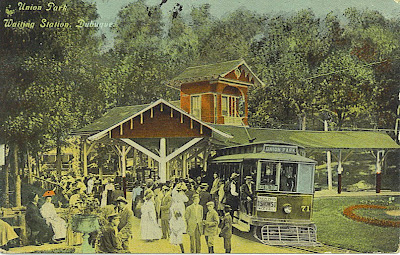 It was exactly 90 years ago today at that a storm descended upon what is now Union Park Hollow (formerly known as Horseshoe Hollow). The forecast called for cloudy skies, but nothing could foresee the devastation that was to arrive that day. The storm unleashed over 2" of rain in just a few hours leaving a path of death and destruction in its' wake. A total of 7 people died in the Dubuqueland area including 5 in Union Park. Damages to the park totaled around $15,000 or $184,890.17* today. Total damages to the surrounding area reached between $75,000 - $100,000 or between $924,450.87 - $1,232,601.16* today.
It was exactly 90 years ago today at that a storm descended upon what is now Union Park Hollow (formerly known as Horseshoe Hollow). The forecast called for cloudy skies, but nothing could foresee the devastation that was to arrive that day. The storm unleashed over 2" of rain in just a few hours leaving a path of death and destruction in its' wake. A total of 7 people died in the Dubuqueland area including 5 in Union Park. Damages to the park totaled around $15,000 or $184,890.17* today. Total damages to the surrounding area reached between $75,000 - $100,000 or between $924,450.87 - $1,232,601.16* today.Although the park reopened a few days later, it never quite recovered from the financial loss of that fateful day. Other factors contributing to its' demise included the popularity of automobiles and competition with another popular Dubuque attraction called Eagle Point Park (which is still in operation today).
This blog features entries with postcards and photographs of the park as it once was and as it is now. The images are arranged in the same order as they would appear if you were walking down the Union Park Promenade yourself. So take a stroll through these images and visualize a carefree yesteryear where the distractions of cell phones, leaf blowers, and lawn mowers were non-existent. Enjoy your trip!
*Today's prices calculated on 6/9/09 using the Inflation Calculator at the U.S. Bureau of Labor Statistics.
Subscribe to:
Posts (Atom)

